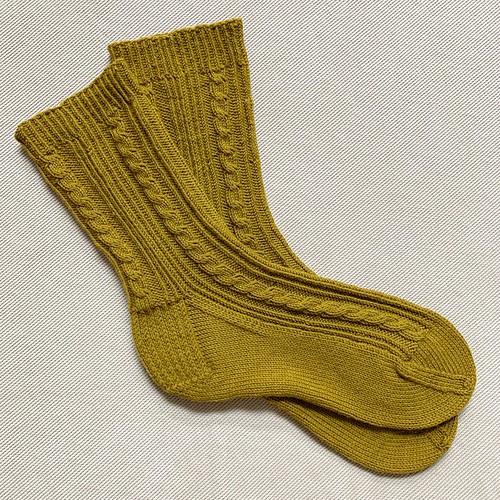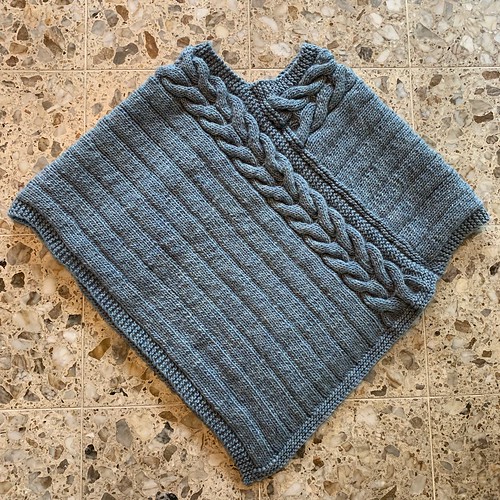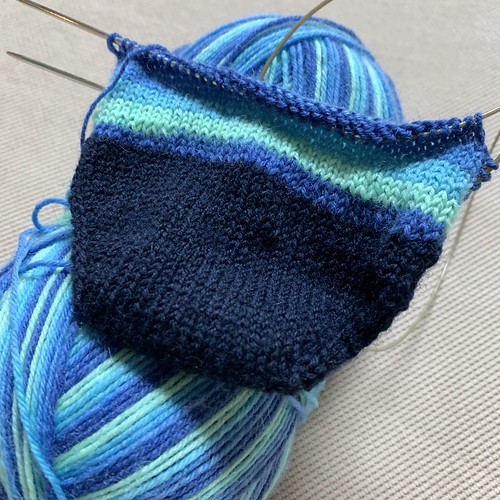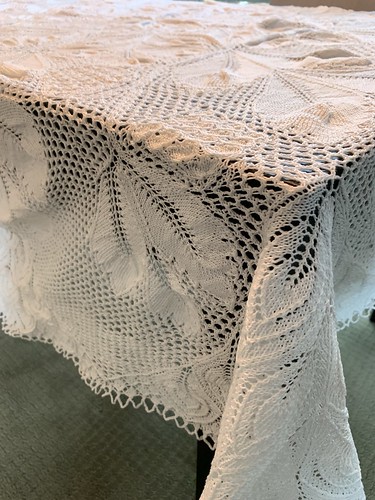After months of knitting with cotton yarn on 2mm needles, my hands and my brain needed some big needle therapy -- forgiving wool, large gauge, easy-to-see stitches and quick progress. But first, I had to wrap up some loose ends.
Because the tablecloth was getting bulky and the chances of major knitting disasters at such a late stage in the process were getting higher, I decided to leave it at home when we traveled to Zion National Park at the beginning of the year. I always want to have something to work on for in the air or in the evenings when away from home, so I cast on for a pair of socks using some yarn given to me by my friend Jene at Christmas. Thus, the Fickle Step Socks. They're knit on 2.25 dpns using Quince & Co. Finch sock yarn in a colorway called Honey. Such a great matchup of yarn and pattern. By the time I'd finished the tablecloth, I'd been taking this project around to knitting get-togethers, but hadn't made a whole lot of progress. But as soon as the tablecloth was done I launched right in before the momentum wore off.
The cables use a double wrap on the row before the stitch crossing, which creates less pull on the lower stitches. At first, I wasn't sure I liked it, but after blocking, the effect is quite nice. I have a tendency to torture cable stitches and this is a handy antidote to that. Not sure if it would be appropriate in all cases, but it worked here. It also made crossing stitches without a cable needle a breeze.
Then it was on to a project and yarn that were both outside my wheelhouse, but just the thing I needed -- the Arrowhead Poncho by Pat Walker using Kraemer Yarns Mauch Chunky in a color called Blueberry Ice, also a gift.
It uses 6.5mm (US10.5) needles. I can't remember the last time I knit something on needles this large. It went by so fast! Thirteen days from cast-on to seaming. The pieces were finished pretty much in the first week, and this week was just blocking and waiting for some time to be able to piece this together.
It's a cool construction -- two long rectangles (mine were 33" x 20") with ribbing across and a couple of squishy cables on one side. Then you sew the two pieces together in a twisted way that creates this natural poncho shape with beautiful cables to frame the wearer's head. On this one, I did use a cable needle. Four-over-Four is a bit much for trying to knit without one. I did attempt it -- once. Then I dug out a cable needle. This thing is warm and heavy. It's not for me, and I'm not sure what I'm going to do with it. I'm leaning toward donating it to a silent auction that my medical librarians' group holds in the fall. We'll see. For now, I'll just admire it.
Already on to more things! I'm working on some self-striping toe-up socks using some yarn I got over the holidays. They're going to have a contrasting toe and heel. And I'm thinking of incorporating German short rows. I've never used them in a pattern before, and I'm looking forward to it. I had a bit of a problem visually while trying to do the increases on the toe with this dark yarn, so I'm anticipating a bit of trouble, but fiddle-dee-dee.
I'm also thinking ahead to sweaters. I'd like to make Ann Budd's Cambridge Jacket because I fancy a zippered cardigan. I like the purl lines that make this interesting -- and will likely help with the fit. It's been a while since I've worked with a zipper so I think I'm up for that challenge.
I also just saw an episode of the current season of Project Runway that had a sweater that really called out to me. It was worn by contestant Sebastian Grey. I kept driving Jeff nuts by pausing the show every time it came on so I could make note of some different aspect of it. I like that it has some fairly muted "me" colors interspersed with stripes in tangerine and lemon yellow, which are so not my thing. But it looks good here.
I think I could backwards engineer this. It looks like a set-in sleeve, but I think it might work also as a raglan. All the colors looked heathered up close -- the tan, the dark teal and the charcoal gray. I'm thinking solids might work better, but this doesn't look wrong. Something to think about...
As you can see, getting out from under that tablecloth (literally), has really unleashed my creativity. Hope you're feeling the urge to knit all the things like I am!
Saturday, March 30, 2019
Big Needle Therapy
Tuesday, March 12, 2019
Three Hundred Ninety-Three Thousand Six Hundred Stitches
How do you measure,
measure half a year?
I finally finished up my Tannenzapfen tablecloth designed by Herbert Niebling this past Sunday. It was technically 393,636 stitches (not counting the crocheted bindoff edging) and took me six months and a day to complete. And there's over three miles of crochet thread in this thing.
I didn't post anything here about progress while I worked on this. When working on a stranded knitting or cables, or even plain stockinette, you can immediately see results and take joy in admiring what you've created so far. There are little milestones that allow you to take stock and reassess. But knitting lace is all about deferred dreams. After the first little bit, it's just a wad of holes sitting in your lap. It's hard to photograph, and nothing looks like it should. When it finally comes off the needles, you can see a bit of the potential, but you just don't have any sense of payoff until the blocking. And six months is a long wait for a payoff.
At first, I thought that the pine cone motifs, the tannenzapfen, would be the most interesting part. They were actually kind of a pain to knit. I ended up using thin crochet hook because I found knitting all those stitches together rather difficult. I do like how they look now, but it turns out I really like the large leaf-shaped portions best. They almost look like solid fabric next to the super-lacy double yarnovers surrounding them. They were the most boring parts to knit, but seem to me to be the most visually interesting in the end.
The instructions I used, a simplified and translated version from Doilyhead, said to simply bind off after the 405th round. But I wanted some sort of edging, so I worked out a system where by 11-stitch crocheted chains ended by gathering up 3 and 5 stitch sections along the edge. I worked a few of these into round 405, didn't like the way they worked with the previous round's yarnovers, and went ahead and added a 406th round of plain knitting. It looked much better. And after knitting 405 rounds, adding another one wasn't all that hard a decision to make.
Blocking this thing is a bit of a bear. It comes from making something knit in the round turn out as a square, which only gets one to square-ish. If you look at the whole thing in eighths, you can see that the corners are where you add some extra stitches. But it still doesn't come out right. There are lumps in the leaf motif that I'm not super happy with. I wonder if ironing the leaves flat would make the tension move out to the double yarnover sections, which, being lacier, might relax and also lie flat?
There, of course, things I wish I'd done differently. I still had some of those plastic-y ring stitch markers which worked great as visual cues for the beginning and ending of repeat sections. However, at this small gauge, the ring was thick enough to create a noticeable gutter through some parts of the fabric, even in the double yarnover sections. I'm saving those for projects on bigger needles only from now on. I also wish I'd stuck with just the jumbo put-ups of Aunt Lydia's Classic 10 crochet thread. Toward the end, I thought I'd just need a regular ball to finish, and ended up needing more. I think I made five Russian joins as I moved from one ball to another during this project. I could have gotten away with just three if I'd planned better.
Immediately after setting this out to block in the afternoon, I picked up the socks I started at Zion National Park. I'd only just gotten past the gusset decreases on the first sock when I sat down. By the time I was ready for bed, the first sock was done. It felt so good to be knitting something else!
Subscribe to:
Posts (Atom)






